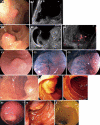Neuroendocrine tumors of the small bowels are on the rise: Early aspects and management
- PMID: 21160582
- PMCID: PMC2998818
- DOI: 10.4253/wjge.v2.i10.325
Neuroendocrine tumors of the small bowels are on the rise: Early aspects and management
Abstract
Neuroendocrine tumors of the small bowel are on the rise. In the US they have increased by 300%-500% in the last 35 years. At the same time their prognosis is much improved. Today, most neuroendocrine tumors (NETs) of the duodenum are detected "incidentally" and therefore recognized at an early stage. Duodenal NETs which are well differentiated, not larger than 10 mm and limited to the mucosa/submucosa can be endoscopically resected. The management of duodenal NETs ranging between 10 and 20 mm needs an interdisciplinary discussion. Endoscopic ultrasound is the method of choice to determine tumor size and depth of infiltration. Surgery is recommended for well-differentiated duodenal NET tumors greater than 20 mm, for localized sporadic gastrinomas (of any size) and for localized poorly differentiated NE cancers. Surgery is recommended for any ileal NET. Advanced ileal NETs with a carcinoid syndrome are treated with long-acting somatostatin analogs. This treatment significantly improves (progression-free) survival in patients with metastatic NETs of the ileum. For optimal NET management, tumor biology, type, localization and stage of the neoplasm, as well as the patient's individual circumstances have to be taken into account.
Keywords: Cancer; Carcinoid; Duodenum; Gastrinoma; Ileum; Jejunum; Multiple endocrine neoplasia.
Figures


References
-
- Modlin IM, Oberg K, Chung DC Jensen RT, de Herder WW, Thakker RV, Caplin M, Delle Fave G, Kaltsas GA, Krenning EP, Moss SF, et al. Gastroenteropancreatic neuroendocrine tumours. Lancet Oncol. 2008;9:61–72. - PubMed
-
- Yao J, Hassan M, Phan A, Dagohoy C, Leary C, Mares JE, Abdalla EK, Fleming JB, Vauthey JN, Rashid A, et al. One hundred years after ”carcinoid”: epidemiology of and prognostic factors for neuroendocrine tumors in 35,825 cases in the United States. J Clin Oncol. 2008;26:3063–3072. - PubMed
-
- Hemminki K, Li X. Incidence trends and risk factors of carcinoid tumors: a nationwide epidemiologic study from Sweden. Cancer. 2001;92:2204–2210. - PubMed
-
- Hauso O, Gustafsson BI, Kidd M, Waldum HL, Drozdov I, Chan AK, Modlin IM. Neuroendocrine tumor epidemiology: contrasting Norway and North America. Cancer. 2008;113:2655–2664. - PubMed
-
- Hassan MM, Phan A, Li D Dagohoy CG, Leary C, Yao JC. Risk factors associated with neuroendocrine tumors: A U.S.-based case-control study. Int J Cancer. 2008;123:867–873. - PubMed
LinkOut - more resources
Full Text Sources

